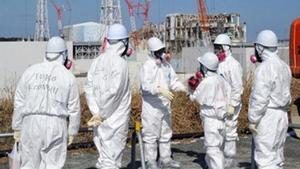Nuclear operationsJapanese government’s nuclear safety inspectors first to flee damaged Fukushima plant
Safety inspectors with the Nuclear and Industrial Safety Agency(NISA), Japan’s nuclear watchdog body, were the first to flee when the March 2011 magnitude-9.0 Great East Japan earthquake and tsunami struck the Fukushima No. 1 nuclear power plant. The absence of the nuclear safety inspectors compromised communications between the government and the plant operator, Tokyo Electric Power Company(TEPCO).

Safety inspectors at Fukushima // Source: tamu.edu
Safety inspectors with the Nuclear and Industrial Safety Agency (NISA), Japan’s nuclear watchdog body, were the first to flee when the March 2011 magnitude-9.0 Great East Japan earthquake and tsunami struck the Fukushima No. 1 nuclear power plant. According to theAsahi Shimbun,plant manager Masao Yoshida, who died in 2013 of esophageal cancer, testified to the government’s Investigation Committee on the Accident at the Fukushima Nuclear Power Stations claiming that four days after the accident, 90 percent of workers in the plant evacuated to the Fukushima No. 2 nuclear power plant roughly ten kilometers away, despite Yoshida’s order to remain in and around the perimeters of the No. 1 facility.
Yoshida went further to say that even before workers fled the facility, NISA inspectors withdrew immediately to a makeshift government headquarters five kilometers from the No. 1 plant, even though they should have stayed to assess the accident. The makeshift facility was later transferred fifty kilometers away to Fukushima city. The absence of the nuclear safety inspectors compromised communications between the government and the plant operator, Tokyo Electric Power Company (TEPCO).
Forced to rely on TEPCO for accurate information, Japanese prime minister Naoto Kan formed a joint control center with TEPCO in Tokyo, 230 kilometers away from the plant, to monitor the risk at the Fukushima plant.
The Japanese government has since reviewed its protocols to deal with nuclear disasters and have made a few changes. In a future nuclear emergency, safety inspectors with the Nuclear Regulation Authority (NRA), the successor to NISA, must remain in an “emergency office” based in the command center of a nuclear power plant to gather information. The new protocols do not specify how long inspectors or other government officials should remain in the emergency office or specifically what information should be gathered. The National Personnel Authority orders that during a nuclear accident, the radiation exposure to public servants must not exceed 100 millisieverts. The limit was temporarily raised to 250 millisieverts after the Fukushima accident, but since December 2011 the limit has been abolished and no new limit has been issued.
When a future nuclear accident occurs, the prime minister will order the Self-Defense Forces or other government organizations to support evacuation and risk assessment efforts. “In effect, it only means that the government supports the operator of a plant where the accident took place,” said Hideka Morimoto, deputy secretary-general of the NRA. The government still expects the plant operator to take the lead role on plant evacuation and clean up efforts should a future nuclear accident occur. “We are not assuming that an accident the operator cannot control will take place,” said NRA chairman Shunichi Tanaka.
